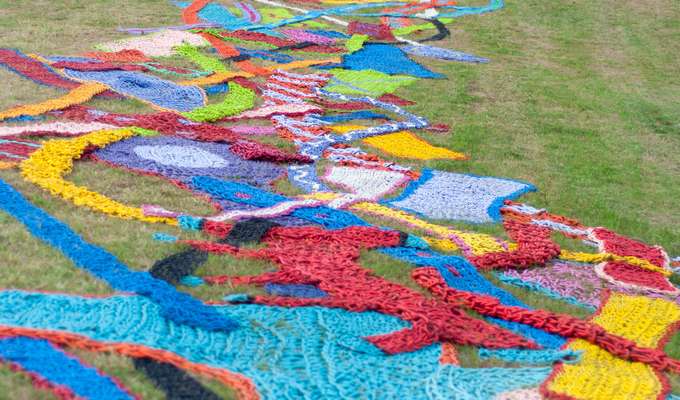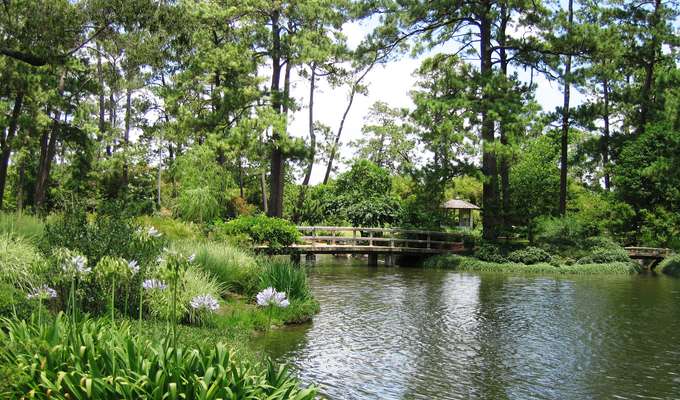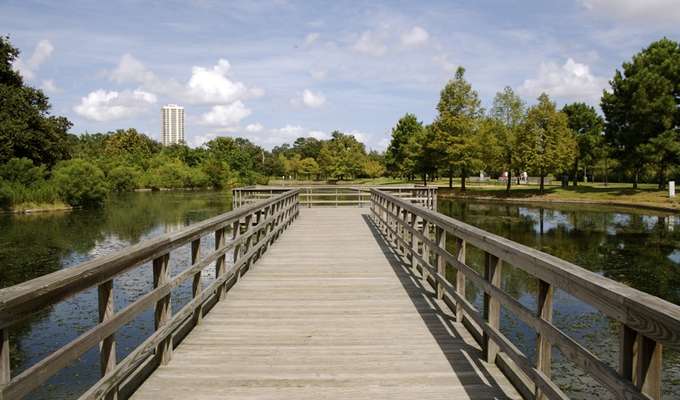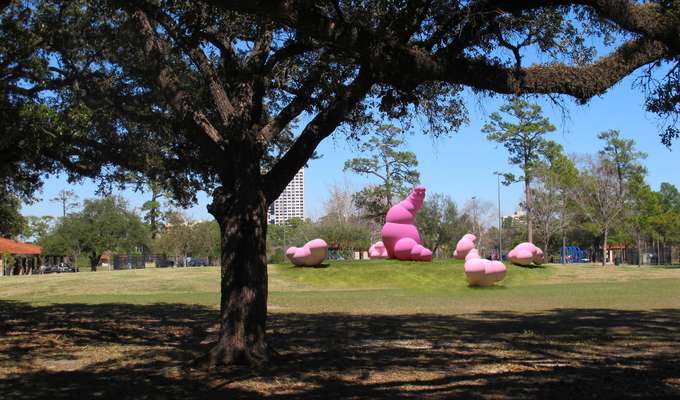STOP 1.
BAYOU PARKLAND

Bayou Parkland is an 80-acre oasis for native plants and wildlife, nestled along Brays Bayou. Scenic trails, wetlands, prairie meadows and an urban forest offer a diverse nature experience. A multi-use pavilion provides a comfortable place for picnics. The area was once cut off from the Heart of the Park, but is now accessible through a pedestrian underpass below North and South MacGregor.
STOP 2.
BOYS CRY TOO BY ORLY GENGER

New York-based artist, Orly Genger, re-imagined a previous work for Hermann Park’s landscaping alongside Brays Bayou. An emerging talent, Genger has garnered attention for her large-scale constructions of brightly painted, knotted nautical rope. Spanning the genres of craft and fine art, Genger mines the intimate, domestic, and traditionally feminine practice of knitting to create sprawling, monumental installations. Genger’s Boys Cry Too lies directly on the grass and measures 225 feet long and 17 feet wide. Boys Cry Too is painted in a wide range of colors including Eggnog, Springtime Bloom, and Limeade. Boys Cry Too will be on view until March 2015.
For more information, please visit the Art in the Park section.
STOP 3.
JAPANESE GARDEN

Japanese Garden Hours:
March 1 - October 31: 9 a.m. – 6 p.m.
November 1 - February 28: 9 a.m. – 5 p.m.
With its waterfalls, bridges, and stone paths that wander among crepe myrtles, azaleas, Japanese maples, dogwoods, and cherry trees, the Japanese Garden is a peaceful hideaway in Hermann Park. The garden was designed by world-renowned landscape architect, Ken Nakajima. Natural materials are used, such as rock, wood, and plants, to give a feeling of serenity. The Japanese Garden features a teahouse and winding paths to explore the lush gardens.
On October 19, 2012, 20 cherry trees were planted in the garden to commemorate the original gift of cherry trees to the United States by Japan in 1912.
The Japanese Garden is open daily for your enjoyment and there is no admission charged.
The entrance to the Japanese Garden is near the Pioneer Memorial obelisk just off Molly Ann Smith Plaza near the Heart of the Park. The closest parking lot is Lot A located just off Sam Houston Monument circle. To get to the Japanese Garden from Lot A, follow the decomposed granite path along the Jones Reflection Pool under the double allée of trees and you'll see the entrance just off the plaza with the obelisk. View our interactive map for more information.
For more information on the history of the Japanese Garden, click here to visit the Houston Parks and Recreation Department's page.
The Japanese Garden is not available for rentals. For more information call 713.284-8300 or 713.284.1300.
STOP 4.
BOB'S FISHING PIER

Fishing is permitted at Bob's Fishing Pier along the western side of the lake beyond the green buoys. It is restricted to those aged 12 and younger and 65 and older. A Texas fishing license is required for those aged 65-70. “Catch and Release” is recommended.
STOP 5.
DILLIDIIDAE BY SHARON ENGELSTEIN

A former Core Fellow and a resident of Houston for many years, Sharon Engelstein is known for her organic, bubbly sculptural forms. For Hermann Park, Engelstein designed one taller element, Mamadillidiidae, poised on the site surrounded by several smaller pieces called Dillidiidae. These “wandering” forms are not immediately recognizable as identical quintuplets but will appear to be quite different in their various positions on the knoll. The tumbling forms invite interactivity and draw visitors due to their vibrant hues.
Dillidiidae will be on view through April 2017.
For more information, please visit the Art in the Park section.